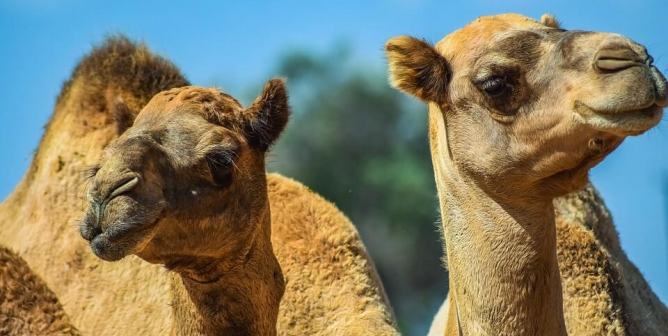Great Apes Used in TV, Film, and Ads
Unlike humans, no ape ever dreams of going into showbiz. To them, acting is stressful, confusing, and often torturous. Chimpanzees and orangutans destined for use in television, film, and advertisements are torn away from their mothers as infants and subjected to harsh beatings in order to make them perform highly unnatural behaviors on cue. At the end of their “careers,” apes are usually dumped at shoddy roadside zoos and other substandard facilities, where they may spend the rest of their long lives in small, filthy cages—often without proper companionship.
Studies have shown that the prevalence of great ape “actors” on film and television misleads the public into believing that these animals are not critically endangered, which couldn’t be further from the truth. Portraying apes as human caricatures conveys the inaccurate message that primates enjoy performing confusing, unnatural tricks for our amusement and encourages people to acquire these extremely dangerous and complex animals as “pets.” With all the highly advanced technologies that are available today, there is simply no excuse for subjecting apes to a lifetime of misery as “actors.”
Unwilling ‘Child Actors’
Great-ape trainers like to use vulnerable ape babies who will be easier to dominate and handle, so infant chimpanzees and orangutans are prematurely torn away from their mothers—sometimes when they are only days old. This has disastrous consequences for the animals’ psychological and emotional development and is also devastating to their mothers, who are often forcibly restrained when their infants are stolen from them.
In the wild, apes stay close to their mothers until they are at least 8 years old. Removing them from their mothers prematurely causes lifelong emotional scars and often leads to a fear of the unknown. Primatologists such as Dr. Jane Goodall assert that young apes learn socially by watching and imitating adults in their communities, just as human children do. Apes who are deprived of their mothers and normal social groups never learn how to interact with others properly and often have trouble integrating into groups when they become adults.
The Breaking Point
Normal, healthy young apes are naturally playful, curious, energetic, and mischievous—all traits that are diametrically opposed to performing complex behaviors on cue. In order to show apes “who’s boss,” trainers “break their spirits” by beating the animals with fists, wooden sticks, rocks, or even metal rods.
According to Sarah Baeckler, a primatologist who led an undercover investigation at a training compound called Amazing Animal Productions (formerly Amazing Animal Actors), “The trainers physically abuse the chimpanzees for various reasons, but often for no reason at all. If the chimpanzees try to run away from a trainer, they are beaten. If they bite someone, they are beaten. If they don’t pay attention, they are beaten. Sometimes they are beaten without any provocation or for things that are completely out of their control. … I was specifically instructed to hit or kick them at the first sign of any aggression or misbehavior.”
Young apes live in fear of their trainers and are constantly trying to anticipate the next blow, which keeps them “on their toes” and attentive to trainers’ commands. In fact, the chimpanzee “grin” so often seen in movies and on TV is actually a grimace of fear.
Animals Were Harmed in the Making of This Movie!
The American Humane Association’s (AHA) “No Animals Were Harmed” seal of approval is extremely misleading to filmmakers and audiences alike. The AHA does not monitor pre-production training, the living conditions of animals off set, the premature separation of infants from their mothers, or the disposition of unwanted animals. The organization, which is funded by the Screen Actors Guild, rarely, if ever, files formal complaints when animals are mistreated. For example, a chimpanzee was beaten on the set of Speed Racer in 2008 in view of an AHA monitor. The AHA did not file charges and allowed the abusive trainer to continue working the animal. The AHA actively defends the use of great apes in film and television productions despite the well-documented abuse and expert testimony confirming that great apes cannot be trained for entertainment without subjecting the animals to physical abuse. You can help by boycotting films and television shows that exploit great ape “actors” and by supporting productions that make use of creative alternatives, such as computer-generated imagery (CGI) and animatronics.
Used and Discarded
Unlike human stars, ape “actors” don’t have happy retirements to look forward to at the end of their careers. Chimpanzees can live to be 60 years old, and orangutans can live to be 50, but their usefulness to the entertainment industry is usually over by age 8, when they become too strong and dangerous to be managed.
After they are discarded at poorly run roadside zoos and other substandard facilities, former ape actors may spend decades in small, barren cages—often in solitary confinement. They may be bred repeatedly to provide a continuous supply of newborns for the entertainment industry. PETA found Chubbs, a chimpanzee who was used in Tim Burton’s Planet of the Apes and in The Chimp Channel series, languishing in a seedy roadside zoo in Texas called Amarillo Wildlife Refuge. Chubbs was living on dog food and rotten produce.
Alternatives to Apes
There is no reason to use live apes in film and television productions when animation, animatronics, CGI, and other highly advanced technologies can produce realistic substitutes. Many films—including Avatar, Fantastic Mr. Fox, Jurassic Park, The Chronicles of Narnia, the 2005 remake of King Kong, The Perfect Storm, and Star Wars: Episodes I, II, and III—have used these technologies to create realistic animals and other characters.
Producers and studio executives may claim that alternatives are too expensive or time-consuming, but considering that the average budget for a studio film is nearly $60 million, animatronics or CGI can account for as little as 1 to 2 percent of a film’s total cost. For such a tiny fraction of a film’s budget, an ape can be spared a lifetime of fear and suffering. It’s time that all of Hollywood caught up to the 21st century.
You can help. Avoid film and television productions that exploit great ape “actors.”




